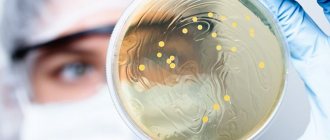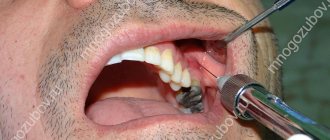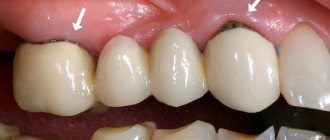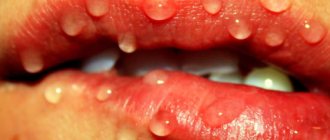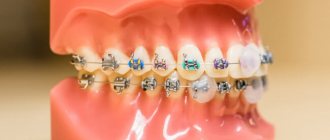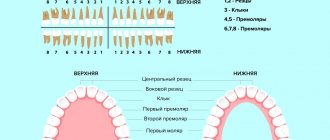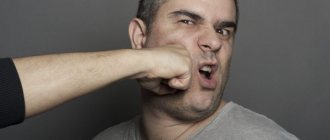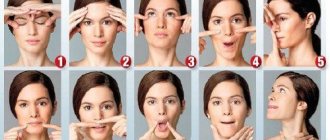The human body is by nature asymmetrical. If you look closely, you can see a slight difference between the length of the arms and legs, the size of the eyes and ears on the right and left sides of the body.
Usually these differences are quite minor and not noticeable, but in the case of infants, everything is different. The most common type of asymmetry in infants is different eye sizes.
In some cases, the difference is noticeable at birth, in others it appears in the first weeks of life. This nuance becomes a cause for concern for new parents. What are the reasons, and is there any cause for concern in a situation where a baby has one eye larger than the other?
Reasons why one cheek is larger than the other
In fact, every person has a difference between one half of the face and the other; they are different, but in some it is less noticeable and in others the defect is very pronounced. Appearance plays a big role in our world. This is how they “meet” a person. In the requirement column for many positions there is a “good appearance” item. Therefore, every person cares about how he looks. Sometimes, when looking at yourself in the mirror, you may notice that one cheek is larger than the other. What is this, a disease or this body structure? – this is the question asked by those who saw such a flaw. Today we will dispel all your doubts and conduct a short master class on restoring asymmetry.
Main reasons for asymmetry
The main causes of facial asymmetry in newborns include:
- uneven development of the bones of the facial skull caused by intrauterine trauma. In a baby, asymmetry can be caused by incorrect presentation, entanglement in the umbilical cord, etc.;
- muscular dystonia, that is, a change in the tone of facial muscles;
- damage to the facial nerve that was caused by compression with obstetric forceps;
- passage of the birth canal in a breech or transverse presentation. In this case, during childbirth, the head is flattened too much, and the lower jaw is subject to deformation;
- fractures of the temporal bone during the passage of the birth canal;
- epilepsy. This disease often causes facial asymmetry in newborns. At the same time, diagnosing epilepsy is quite difficult: for this you need to find an experienced specialist.
Often the cause of asymmetry is a disease such as torticollis. It is not difficult to notice this pathology and distinguish it from others: with torticollis, the entire body of the baby is bent in one direction. Unfortunately, if treatment for torticollis is not started in time, the muscles will become fixed in a deformed state, that is, the location of the facial tissues will change. As a result, one eye remains slightly dilated, the corners of the mouth shift, and the mouth itself becomes distorted.
Below, the reasons why facial asymmetry occurs in a newborn will be discussed in more detail.
Epilepsy of newborns
Epilepsy in newborns, which can cause the development of facial asymmetry, is quite difficult to diagnose. After all, the baby is not yet able to communicate about its condition, and a convulsive seizure can easily be confused with uncoordinated movements characteristic of any infant.
Seizures in a child can develop due to local brain damage during childbirth, hemorrhages and even strokes. Epilepsy also affects the symmetry of a child’s face. For example, you may notice that one nasolabial fold is smoother than the other, one eye opens wider than the other, etc.
Torticollis: manifestations and treatment
In children, torticollis, which is a congenital pathology of soft and bone tissues, usually appears two to three weeks after birth. Torticollis occurs in approximately 2% of children, and girls suffer from this disease much more often than boys.
The main cause of torticollis is a pathology of the sternocleidomastoid muscle, which for some reason loses its elasticity.
During childbirth, the sternocleidomastoid muscle is injured during the passage of the birth canal, as a result of which a scar is formed in place of the muscle tissue, holding the baby's head in a certain position.
Pathology of the sternocleidomastoid muscle can occur due to intrauterine infection or due to the fact that the child is awkwardly positioned in the uterus. Torticollis can also develop due to entanglement in the umbilical cord or during breech presentation.
Torticollis can form due to the fact that parents hang toys on only one side of the crib. The baby is forced to constantly keep his head in one position, as a result of which the muscles of the neck and face are deformed.
Birth injuries
Unfortunately, they often become the reason that forces young parents to treat their baby for a long time after he is born.
The causes of birth trauma can be not only the inept actions of midwives, but also a number of other factors, for example, too narrow a pelvis, illness of the pregnant woman, post-term pregnancy. Also, birth injuries are caused by breech presentation of the fetus and its too large size, intrauterine hypoxia, abnormal labor (too fast or too long labor), etc.
The reason why facial asymmetry develops in a newborn is usually the incorrect use of obstetric instruments, for example, forceps, a vacuum extractor and others.
The result of birth trauma can be damage to the facial nerves, which causes asymmetry. This is a serious complication that can remain with the child for a very long time, so you should immediately contact a doctor with such a problem.
Reasons why one half of the face is larger than the other
Many people complain that one side of their face is different from the other. This becomes noticeable when carefully examining yourself in the mirror or in unsuccessful photographs. Some, noticing that their cheeks are different, begin to “sound the alarm” fearing that they are sick.
Variations in the structure of a person’s face that exceed the natural differences in the right and left halves in significant quantities are considered deformities
In fact, slight asymmetry is present in absolutely every person. This is what makes our face alive, unique and inimitable.
To make sure that each person is not symmetrical, you can take several photos of your friends and cut them into two equal parts along the line of the nose in a photo editor. Now one of the right halves is “mirrored” and connected to the other, and we do the same with the left parts. Take such photographs of several people, and you will see that the faces of the right and left halves of the same person are very different.
However, different halves of the face are not always the norm. Let's look at what factors can lead to pathological changes.
Reasons why one side of the face looks very different from the other:
- Improper development of bones and joints, as well as connective or muscle tissue. Such problems can be more or less pronounced, they can only be corrected with proper makeup or plastic surgery.
- Inflammation of the cheek can also lead to its enlargement. After eliminating the problem, the face acquires normal contours.
- Severe strabismus can also develop facial asymmetry. The same applies to torticollis.
- Facial muscles can become severely distorted when nerves become pinched or die. This problem often occurs with strokes and heart attacks.
- An incorrect bite or missing teeth on one side can lead to facial asymmetry. Flux can also cause a similar problem.
- A fracture of the facial bones that did not heal properly.
- The habit of chewing, sleeping or squinting to one side is the most common cause of facial asymmetry.
There are many reasons. Some of them can be avoided by taking timely treatment and controlling your facial expressions.
Facial asymmetry - causes, methods of correction in women
Facial asymmetry is a very pressing problem. Many people are interested in the question: is this a disease or a cosmetic defect? Let's try to take a closer look at this issue and understand it.
Reasons why facial asymmetry occurs
Look in the mirror, and suddenly you discover that the right and left sides of your face seem to be similar to each other, but the other is not. Either one eyebrow does not correspond to the other, or the eyes are somehow different: one is larger, the other is smaller.
What are the causes of facial asymmetry?
- The root cause is the mystery of birth. This is accompanied by incorrect construction of the skull bones.
- The joint responsible for connecting the lower jaw and temple develops with disruption.
- Muscle and connective tissue interact weakly with each other.
- The lower jaw develops slowly.
Past injuries, illnesses, insufficient oral and dental care are already acquired problems. There are quite a lot of them.
- One of them can lead to torticollis if the child lies on one side for a long time.
- Vision problems that are accompanied by strabismus.
- Infections and inflammations that cause pinching or damage to the facial nerve.
- The bones of the face did not heal properly after a fracture of the bridge of the nose.
- Missing teeth or malocclusion, as well as the bad habit of squinting one eye, are not all the reasons for facial asymmetry.
Often severe facial asymmetry occurs after a stroke. Muscle paralysis occurs.
Correction of facial asymmetry
If flaws in the form of asymmetry suddenly appear in your face, this is not yet a reason to radically change your appearance.
You can just use cosmetics and place the accents correctly. In this case, you need to use foundation and correctors. They can be oily or dry. In addition, she uses highlighter in her work.
It is needed to visually hide wrinkles or highlight the necessary part.
The asymmetry of the eyes will not be so noticeable if they are not outlined with bright eyeliner. It is better to have tones close in color on hand, to make a soft transition from one color to another. Pencils with a contrasting color will also come in handy. On the inside of the eye, which we want to visually enlarge, it would be good to apply a lighter tone. On the eyelid of the second eye we apply an almost invisible line of dark color.
If the eyes, in your opinion, are still asymmetrical, then you need to place emphasis on the eyelashes and eyebrows. Eyebrows need to be given the perfect shape and arch. Latisse can enhance your eyelashes. A brown pencil can always highlight light eyebrows. And if you pluck an eyebrow that is higher than the other and draw on the eyebrow line with a pencil, your face will take on a completely different expression.
You need to have foundation creams on hand to be able to visually change the shape of your nose. The golden rule: a dark tone is applied to those places that need to be hidden or visually reduced.
A lighter tone is used to highlight certain parts of the nose. To make the nose look good, you need to draw a line along the nose in a tone that is darker than natural.
And leave a light light highlight on the wings of the nose and its tip.
A contour pencil helps give the lips the desired shape. And then the lips visually lose their asymmetry. You can correct your cheekbones with regular blush. To do this, you need two half-tone blushes that are close in color. They are applied along the cheekbone line, and their heights are different.
Most popular: Does your facial skin need thermal water from the depths of the earth?
How to align different halves of the face
If you have identified the fact that the face has significant differences on both sides due to some kind of disease, then to determine the cause, you need to visit a doctor. The specialist will prescribe tests for you, perform an examination and advise the correct treatment.
With good reason we can say that there is not a single person with absolute symmetry of the right and left halves
Asymmetry can occur as a result of drug use. In this case, the face often becomes gray.
To determine the cause of pathological facial asymmetry, you need to visit a doctor. In fact, you may need a number of specialists, but it is best to visit your doctor first.
In this case, you will not waste a lot of time visiting unnecessary medical professionals. The specialist will make a list of doctors you need to visit.
What doctors may be needed for asymmetry:
Once the cause of your illness is discovered, you can undergo treatment and return everything to normal. However, in some cases, additional plastic surgery may be required after treatment.
Reasons for different eye sizes in babies
Almost all babies are born with an irregularly shaped skull, but as they develop, the bones fall into place and the shape of the head straightens out. The situation is completely different with the pronounced difference in the size of the right and left eyes. In the first minutes of life, the baby is examined by several doctors at once. One of them is a pediatric orthopedic doctor. He must determine the causes and severity of the visual defect.
There are several reasons:
Here we should talk about changes in the bones of the skull, soft tissues and nerves of the face. These changes lead to a significant difference between the left and right halves of the face, which is reflected in the size of the eyes. There are several factors leading to the appearance of eye asymmetry:
- Incorrect formation of the fetal skull bones in the womb. At the stage of development of the skeletal system, the child’s body, for some reason, does not receive enough of the necessary microelements. Alcohol consumption during pregnancy may also be a cause.
- Birth trauma in which the baby's head is severely deformed. The bones of a newborn’s skull are quite soft, but due to incorrect position of the fetus, for example, breech presentation, they can become deformed during childbirth.
- Muscular dystonia or increased tone of facial muscles. This symptom is associated with disruption of the child’s nervous system.
- Disruption of the facial nerve or damage to it during childbirth.
- As a consequence of another defect - torticollis. The child's head and body are bent in one direction. Over time, changes in facial tissues occur, which leads to the expansion of one palpebral fissure and the narrowing of the other. This disease requires immediate treatment, as it will be much more difficult to correct over time.
Upper eyelid disease - ptosis
This disease is characterized by the weighting of one eyelid, which leads to the fact that the affected eye looks smaller than the healthy one. By its nature, ptosis can be congenital or acquired. Sometimes the disease is recognized only several days after the birth of the child. With this disease, the fold of the upper eyelid on the affected eye is smoothed out, and the eyelid becomes visually higher in relation to the healthy eye. Thus, the eye visually changes size, becoming narrower.
Ptosis is a serious disease
, often leading to serious consequences. Over time, the eyelid can completely close the affected eye, leading to abnormal vision development and astigmatism.
It is worth understanding that any deviation from the norm in a baby is purely individual. Only a specialist can make the correct diagnosis and prescribe treatment. Therefore, the treatment method will be different in each case.
Gymnastics to restore symmetry or how facial muscles work
Facial muscles are constantly working. However, if this occurs unevenly, asymmetry may occur. This problem also often appears with age. If this is not associated with the presence of serious diseases, then the problem can be eliminated with the help of gymnastics.
Exercises to eliminate facial asymmetry:
- The palms hold the muscles and skin of the forehead, while the eyebrows rise as much as possible up and down;
- We open our eyes as wide as possible and hold this for three counts, relaxing our eyes;
- We inflate our cheeks as much as possible, count to three and retract them, again counting to three;
- We inflate and deflate the cheeks one by one;
- Smile from the top of your mouth without showing your teeth, and then form your lips into a tube;
- We move the jaw forward, left and right.
We perform each exercise ten times. If done regularly, exercise will give the first results within a month.
Newborn facial massage
Doll face after three months Massage of the muscles of the body and limbs is given great importance in the first year; it is used for medicinal purposes and for general development. The massage therapist determines the asymmetry of the baby’s body at one glance (muscles on one side of the body that are more trained in “toned” movements and flaccid, weak muscles where there was no room for exercise). To correct the intrauterine installation, a simple technique is used: on the weaker side, the exercises are repeated two to three times more than on the stronger side. For example, there are three exercises for a strong hand, and six for a weak one.
We will use the same training method for facial massage. Mom's hands should be clean and warm. The most comfortable position at an early age for all manipulations with the baby: facing you in the hole on your knees. Perform a massage after feeding, when the baby has worked hard and is happy. If you perform it after each daily feeding, then we will achieve six repetitions per day, then that’s what we need!
The main technique of this massage is stroking. It is performed with three fingers pressed tightly together: the index, middle and ring fingers. Run your fingers over your face several times, achieve the most pleasant touch and remember it. Touch your baby's face in the same way, without pressing or vibrating. Strong impacts are acceptable on the body, but not on the delicate face.
Perform the massage simultaneously with both hands. Look at a baby's face: the side where the eye appears smaller is strong. Here you will do less strokes than with the opposite one. Determine the proportion of touches yourself: 2 and 6, or 3 and 6, depending on the degree of asymmetry.
First, stroke the baby along the hairline from the center of the forehead to the temples. Let’s add a folk proverb to this massage and we’ll get our first developmental lesson. When stroking the hair roots we say: “The forest is thick.”
The next massage area is the forehead. We draw in the middle between the hairline and eyebrows, also from the center to the temples, with the words: “The field is clear.”
Very important eyebrow muscles. The growth lines of the eyebrows themselves are different, and if the muscles also move each in their own way, then the person turns into a two-faced person: surprised on the right, frowning on the left. We stroke the eyebrows from the bridge of the nose to the temples and call it: “Two poplars.”
Then the eyes. We iron the fold that starts in the corner of the eye and runs to the cheekbones: “Two windows.” Have you forgotten that we stroke the weak side two to three times longer than the strong side?
Now the wings of the nose. From the bridge of the nose to the nasolabial triangle: “Rinpump”.
Now fold the nasolabial triangle from the wings of the nose to the corners of the lips, on the strong side two or three times, on the weak side six times: “Battle.”
If your baby's upper lip is constantly parted and pulled up towards the nose, use the edge of your index finger to smooth out the central dimple from the nose to the lip. This movement is unpaired, do it two or three times.
Using our index fingers, we lift the corners of our lips; to do this, we stroke the muscles under the lower lip from the center to the edges, lingering slightly on the corner and emphasizing its raised position: “Laughter.” Don't forget about the number of repetitions rule.
We finish the massage by stroking the neck. The side on which the baby’s head always leans is well trained, therefore we stimulate the muscles of the opposite side with our gentle strokes. The direction of movement is from the skull to the shoulders.
Well, if you want to fight the asymmetry of your own face, then use the same remedy as often as you want! Be beautiful!
Minor facial asymmetry is present in every person, small children are no exception.
Research shows that such disproportion is considered more pleasing than the symmetry of a person's face.
With natural asymmetry, the difference between the sides is invisible to the naked eye. In the first days, mothers spend a long time looking at their baby.
And noticed differences in the sides of the baby's face can cause some concern. In this case, it is best to consult a doctor to exclude the possibility of pathological facial disproportion.
The natural asymmetry of a child's face can be detected in a slight difference in the size of the eyes, just above the set eyebrow.
Scientists have proven that normally the difference between the sides of the face should not exceed 2–3 mm or 3–5 degrees. As a rule, the left side is more feminine, the features are smoothed and elongated vertically.
The right side is wider, with defined features and is considered more masculine.
Therefore, such a slight disproportion should not cause concern for mommy. In children under one year of age, mild asymmetry is considered normal.
If the disproportion of the face is clearly noticeable, manifests itself in a calm state, is expressed in the difference in the placement of the eyebrows, the size of the eyes, a noticeable difference in muscle tone, sagging of one side of the face, then this is considered a pathological change. It is necessary to urgently consult a doctor to find out the cause and prescribe adequate treatment.
Description of facial asymmetry
Normally, imbalances in proportions do not exceed 2-3 millimeters. The left side of the face is characterized by femininity and smoothness of features.
The right side is slightly wider, more defined and sharp. But there are also pronounced facial asymmetries associated with profound disorders.
It is not difficult to distinguish physiological deviations from pathologically disturbed proportions. To do this, just look in the mirror. The deformity is expressed in a skewed chin, noticeable displacement of the corners of the mouth, one cheekbone higher than the other. Jaw displacement is not only a problem of aesthetics, the bite is also disturbed, bruxitis may begin to develop, which as a result is fraught with large inconveniences and expenses during treatment. Find out what to do if your jaw is jammed on one side.
Jaw displacement and facial asymmetry: how to fix it at home
A normal person's face cannot be completely symmetrical. The difference between the left and right sides is practically unnoticeable. You can identify small differences if you look closely at a photograph or carefully study a person.
But in some cases, asymmetry is pathological in nature and this is the reason for contacting a specialist. In most cases, a clear violation of facial proportions is associated with jaw asymmetry. Let's talk about it in more detail.
Description of facial asymmetry
Normally, imbalances in proportions do not exceed 2-3 millimeters. The left side of the face is characterized by femininity and smoothness of features.
They are slightly elongated in the vertical plane.
The right side is slightly wider, more defined and sharp. But there are also pronounced facial asymmetries associated with profound disorders.
It is not difficult to distinguish physiological deviations from pathologically disturbed proportions. To do this, just look in the mirror. The deformity is expressed in a skewed chin, noticeable displacement of the corners of the mouth, one cheekbone higher than the other.
Jaw displacement is not only a problem of aesthetics, the bite is also disturbed, bruxitis may begin to develop, which as a result is fraught with large inconveniences and expenses during treatment.
Find out what to do if your jaw is jammed on one side.
Symptoms of deformation of the jaw, chin, cheekbones
Facial asymmetry has manifestations. Based on these symptoms, a diagnosis can be made:
- sagging cheeks due to weakness of facial wrinkles;
- the affected part of the face takes on the appearance of a mask, the corner of the lips moves down;
- smoothing natural frontal and nasolabial folds;
- the pained expression of the asymmetrical half;
- obvious violation of facial expressions (difficulty closing an eye, lifting a lip or wrinkling a forehead);
- widening of the palpebral fissure.
In complex cases with damage to the facial nerve, symptoms intensify.
Sometimes the signs are accompanied by pain.
If muscle function deteriorates significantly and affects the side of the neck, the patient develops a pathological tilt of the head. Gradually, one cheek sags, and the sore side of the face smoothes out. Often there are problems with nutrition, and pain manifests itself precisely during chewing food. This material will tell you why teeth go numb.
Causes
There are several factors for the occurrence of facial asymmetry. These may include physiological and pathological disorders. The development of incorrect facial proportions is based on cosmetic, neurological, dermatological and dental problems.
Congenital facial defects leading to asymmetry are quite rare.
Usually, deviations are detected already in the prenatal period, when the fetus is actively developing. Sometimes such disorders are accompanied by various syndromes.
There is also senile facial asymmetry. This is due to age-related changes against the background of developing muscle weakness.
Varieties of curvature
The following changes are observed: a crooked mouth, chin, cheekbones, and a skewed jaw to one side.
Congenital and acquired
Congenital:
- abnormal structure of the cranial bones;
- underdevelopment of the lower jaw;
- developmental disorder of the temporomandibular joint;
- improper formation of the neck muscles;
- damage to connective tissues and the muscular system.
Purchased:
- injuries to the face, jaws, facial bones;
- inflammation or pinching of the facial nerve;
- malocclusion;
- complete secondary and primary adentia (absence of teeth);
- strabismus;
- soft tissue atrophy due to systemic diseases;
- torticollis in children.
Physiological reasons
These factors include bad habits. Incorrect posture with a characteristic tilt of the head to the side for a long time leads to facial asymmetry. The face can change if you constantly chew gum on one side of the jaw or squint your eyes.
If a person sleeps on one side for a long time, this leads to facial distortion.
Pathological:
- neuropathic defects of the facial nerve, Bell's palsy;
- facial contracture after paralysis with increased tone on the healthy side of the face;
- synkinesis (involuntary movements of the muscles of the face or eyes);
- dyskinesia of facial muscles;
- pain syndromes on one side of the face;
- myasthenic syndrome accompanied by asymmetry.
Treatment
In most cases, surgery is used to correct asymmetry. Thanks to facial plastic surgery, it is possible to achieve significant alignment of facial proportions.
Surgical intervention
Before plastic surgery, preparation is required. Usually, to diagnose complex facial asymmetry, an external examination, collection of complaints and consideration of anamnesis are sufficient. A study is required to check for possible inflammation and soft tissue infections.
Until they are eliminated, surgical treatment cannot begin. Facial proportions are measured using special instruments. If the affected side is displaced by more than 5 degrees, the doctor suggests various types of correction.
Find out about the removal of a horizontal, recumbent tooth in this article.
A neurologist will help determine the extent of the facial nerve defect. X-rays are required if the asymmetry is associated with facial trauma. In addition to consulting a surgeon, you will need to undergo an examination by an ophthalmologist, neurosurgeon or dentist.
The final stage of preparation for surgery will be magnetic resonance imaging.
Such a study gives an accurate picture of bones and soft tissues.
Types of operations
- Thread lifting. Polydioxanone threads are injected subcutaneously and dissolve on their own.
Gradually, collagen fibers form in their place. Plastic surgery is suitable for patients with physiological asymmetry caused by age-related changes in the facial contour. The procedure lasts 30-60 minutes, the average duration of the effect is 2 years. - Contour plastic. The cosmetic method involves the use of injections or implants.
Thanks to the operation, you can achieve maximum face lifting and eliminate visible asymmetry. Contour plastic surgery has many contraindications, which are voiced by a specialist. - Blepharoplasty .
Used to correct the skin fold above the eye. With the help of eyelid surgery, pronounced asymmetry of the eyes is eliminated. Additionally, blepharoplasty makes it possible to get rid of swelling under the eyes. If the patient has synkinesis associated with neurological abnormalities, eyelid surgery may not be effective. - Browlift. Browplasty is used to move an asymmetrical eyebrow to a higher position. This method is often used if implants alone are not enough or correction of the forehead is required.
- Rhinoplasty. Used to correct the nose after various injuries. The operation lasts no more than 1.5 hours.
Find out about digital orthopantomography of teeth by clicking on this link.
Massages
If asymmetry is not associated with complex injuries and damage to the facial nerve, you can correct your face with the help of massages.
Unfortunately, this is difficult to do at home.
Only a specialist knows the massage lines and is able to restore the contours of the cheeks and other areas of the face. Finger and palm exposure is effective in case of long-term use. It will take 10 to 20 sessions to achieve the effect.
Possible complications: malocclusion, nervous tics
Uncorrected asymmetry or complete lack of treatment can have consequences. This applies to both the physiological and psychological sides:
- twitching of facial muscles;
- involuntary nervous tic of the eyes and other parts;
- increased risk of soft tissue inflammation;
- chronic headaches;
- high blood pressure;
- stress on the jaws and neck.
Often, against the background of incorrect facial proportions, the patient experiences psychological instability. In the social sphere such a person may feel depressed.
To maintain proportions after surgery, you must adhere to the recommendations of the plastic surgeon.
about how to correct facial misalignment
This video will tell you in detail how to correct facial asymmetry.
Conclusion
- Jaw asymmetry is a complex, but still treatable disease.
- In most cases, the defect is eliminated through surgery.
Depending on the nature of the curvature, rhinoplasty, thread lifting, contour plastic surgery, etc. can be performed. - If the asymmetry is not pathological in nature, then it can be reduced through massages.
- After therapy, it is recommended to do facial exercises and follow the doctor’s recommendations.
Find out about the symptoms of a dislocated lower jaw here.
Source: https://ZubZdorov.online/bolezni/zubov/anomalii/asimmetriya-chelyusti.html
Symptoms of deformation of the jaw, chin, cheekbones
Facial asymmetry has manifestations. Based on these symptoms, a diagnosis can be made:
- sagging cheeks due to weakness of facial wrinkles;
- the affected part of the face takes on the appearance of a mask, the corner of the lips moves down;
- smoothing natural frontal and nasolabial folds;
- the pained expression of the asymmetrical half;
- obvious violation of facial expressions (difficulty closing an eye, lifting a lip or wrinkling a forehead);
- widening of the palpebral fissure.
In complex cases with damage to the facial nerve, symptoms intensify.
If muscle function deteriorates significantly and affects the side of the neck, the patient develops a pathological tilt of the head. Gradually, one cheek sags, and the sore side of the face smoothes out. Often there are problems with nutrition, and pain manifests itself precisely during chewing food. This material will tell you why teeth go numb.
Newborn facial massage
The purpose of the massage is to stimulate the neuromuscular fibers, as a result of which they should grow and change their configuration, smoothing out the pathology.
Before you begin the massage, you should remember that it should only be done with clean hands on previously cleansed skin.
It is also necessary to use a special massage cream or gel so as not to damage the baby’s delicate skin. Regular baby fat cream will also work.
Movements should be light, stroking. It is necessary to massage over the entire surface of the face, focusing on the problem area.
According to the general rules, you should start with stroking movements, then you need to use light rubbing movements in order to warm up the muscles. The next set of actions are stretching movements with gentle pressure. The massage should also be completed with stroking.
All movements are made along massage lines, from the center to the periphery.
It is always worth remembering that actions should be careful and associated with pleasure and positive emotions, without causing pain.
The massage begins from the hairline, from the forehead to the temples. And gradually goes down. After repeating the movements 5-7 times, you can move to the forehead.
Using gentle stretching movements, run your fingers between the eyebrows and hairline towards the temples.
It is worth carefully working on the eyebrows, applying light pressure from the bridge of the nose to the temporal area.
Using the same stretching movements with gentle pressure, you need to go over all other areas: nose, cheeks, dimple above the lip. The massage ends with stroking movements of the neck.
Disproportion of a baby's face can be a completely natural phenomenon and go away on its own by the end of the first year. But it can also be a sign of a serious neurological disease, which should be treated as quickly as possible. This means that parents must consult a specialist as soon as they notice even minor changes in the appearance of their child.
Immediately after your baby is born, his head will be slightly deformed. It can even frighten mothers who did not take the time to read specialized literature before giving birth. There is no need to be afraid: during the passage of the birth canal, the bones, which are connected by soft cartilage, folded like a bud to make it easier for the child to be born. As a rule, the head becomes round a few days after birth. But if the baby has an asymmetrical face, this is a reason to visit a specialist. Let's try to figure out why facial asymmetry occurs in a newborn and what to do about it.
Causes
There are several factors for the occurrence of facial asymmetry. These may include physiological and pathological disorders. The development of incorrect facial proportions is based on cosmetic, neurological, dermatological and dental problems.
Usually, deviations are detected already in the prenatal period, when the fetus is actively developing. Sometimes such disorders are accompanied by various syndromes.
There is also senile facial asymmetry. This is due to age-related changes against the background of developing muscle weakness.
Diagnostic methods
Diagnostic measures include:
- X-ray of the skull;
- magnetic resonance imaging of the face;
- general laboratory tests - blood, urine.
MRI
In some cases, an examination of the vascular system of the brain is required - often a curvature of the smile or jaw, cheekbones can be a consequence of a micro-stroke suffered “on the feet”.
Varieties of curvature
The following changes are observed: a crooked mouth, chin, cheekbones, and a skewed jaw to one side.
Congenital and acquired
- abnormal structure of the cranial bones;
- underdevelopment of the lower jaw;
- developmental disorder of the temporomandibular joint;
- improper formation of the neck muscles;
- damage to connective tissues and the muscular system.
- injuries to the face, jaws, facial bones;
- inflammation or pinching of the facial nerve;
- malocclusion;
- complete secondary and primary adentia (absence of teeth);
- strabismus;
- soft tissue atrophy due to systemic diseases;
- torticollis in children.
Natural and pathological
Physiological reasons
These factors include bad habits. Incorrect posture with a characteristic tilt of the head to the side for a long time leads to facial asymmetry. The face can change if you constantly chew gum on one side of the jaw or squint your eyes.
Pathological:
- neuropathic defects of the facial nerve, Bell's palsy;
- facial contracture after paralysis with increased tone on the healthy side of the face;
- synkinesis (involuntary movements of the muscles of the face or eyes);
- dyskinesia of facial muscles;
- pain syndromes on one side of the face;
- myasthenic syndrome accompanied by asymmetry.
How to deal with asymmetry?
The choice of treatment depends on the cause of the disease.
If the reason is low tone, then facial gymnastics, myostimulation and massage have a good effect.
Facial nerve injury is treated in a hospital setting through physiotherapy, electromyography and myostimulation
For more severe pathology, methods such as:
- orthodontic treatment;
- jaw surgery;
- plastic surgery.
For birth trauma or epilepsy, treatment is always individualized. With epilepsy, facial asymmetry is not the biggest concern of parents. To stop seizures, drug treatment is prescribed, and physical therapy can help remove asymmetry. Birth injuries can be cured by massaging your baby's face.
If the cause is torticollis, then the child is prescribed special medications, physiotherapy (electrophoresis) and mandatory massage courses. In addition, at home, proper positioning of the child helps a lot - you need to place the child with the healthy side against the wall. Due to curiosity, the baby will want to see what is happening around him and will turn his head in the opposite direction, thereby stretching the brevis muscle.
Pediatricians advise making a special retainer for the baby’s head - a donut made of sterile cotton wool and a bandage. You can also place bags of cereal on both sides of the baby's head. It is worth fixing the head in this position for 2 hours a day.
In some cases, a Shants collar is used to correct torticollis. Massage and physical therapy help a lot.
Treatment
In most cases, surgery is used to correct asymmetry. Thanks to facial plastic surgery, it is possible to achieve significant alignment of facial proportions.
Surgical intervention
Before plastic surgery, preparation is required. Usually, to diagnose complex facial asymmetry, an external examination, collection of complaints and consideration of anamnesis are sufficient. A study is required to check for possible inflammation and soft tissue infections. Until they are eliminated, surgical treatment cannot begin. Facial proportions are measured using special instruments. If the affected side is displaced by more than 5 degrees, the doctor suggests various types of correction. Find out about the removal of a horizontal, recumbent tooth in this article.
Treatment methods
For facial asymmetry:
- Massage
. Starting from the first days of life, massage can solve the problem of facial asymmetry, thereby returning the eyes to the same size. Massage is prescribed for the tone of the facial muscles, for birth injuries, and for pinched facial nerves. With proper facial massage, blood circulation increases and muscles are toned. If you have torticollis, you should also massage the collar area. At the same time, weakened muscles “train” and acquire the necessary elasticity, which leads to the alignment of the neck and, as a result, all facial features. - Physiotherapy
. With the help of a course of physiotherapy, you can also achieve restoration of correct posture. - To achieve equal size of both eyes, the eyelid of the larger eye is pulled upward and secured using an adhesive plaster. This tension helps smooth out the asymmetrical eyelid.
- In order for the treatment to be effective, you should not forget about the correct position of the baby’s body during sleep. You need to lay the child as straight as possible and change the position of the body during sleep, turning it from side to side.
- Drug treatment
. Prescribed for advanced cases when other treatment options have failed.
For ptosis
:
- Conservative treatment
. Galvanotherapy and UHF therapy are widely used. The method of fixing the eyelid of the diseased eye with a plaster is also used. If these procedures do not give the desired results, it is necessary to resort to surgical intervention. - Surgery
. It is used in most cases, as it is more effective. The operation should be performed at the earliest age of the child in order to avoid complications. The optimal age for such an operation is 4-5 years, when the child’s eyelid tissue has already formed, which will avoid postoperative cosmetic defects.
Different eye sizes in infants are always a symptom of a deviation from the norm or a consequence of some disease. To make a timely diagnosis, do not delay visiting an ophthalmologist. The baby should visit an ophthalmologist at 3, 6, 9 and 12 months. And if the problem exists and is visible from the moment of birth, you should immediately seek advice from a competent pediatric ophthalmologist.
Beautiful people are not born, they are made. Today I will tell you about one important technique for caring for a baby, the explanation of which I could not find on the Internet. This is a facial massage for a newborn. It is indicated for every baby. You can do it without any special skills. The purpose of the massage is to correct natural asymmetry through training weak facial muscles. The maximum effect is achieved if you start it immediately after birth and practice it daily in the first month of life.
For clarity, I will show you two photographs. The first shows a baby at the beginning of life, and this is not the worst case, but we cannot help but notice the asymmetry of the face. It is caused by the fact that the muscles on the right side of the face are in good shape (a consequence of the intrauterine position in the last stage of pregnancy). The right eye appears swollen or squinted, the right half of the mouth is pulled upward in a slight grin. This facial expression does not in the least reflect the child’s state: post-nausea, pre-sleep, relaxed contemplation.
newborn facial massage
If you neglect facial massage in early infancy, you may never give your child the talent to convey his experiences and impressions through facial expressions. The grimace on his face will depend on the initial asymmetry. And, unfortunately, more from her than from his own efforts to master facial expressions. The fact is that our body and face have muscle memory. We don't think when we walk or smile. Therefore, it is so important to get the child’s muscles in order before starting active use and forming a muscle habit. The active development of a baby’s facial expressions begins in the second month of life, which means facial massage should begin earlier. And continue until the effect is achieved.
Possible complications: malocclusion, nervous tics
Uncorrected asymmetry or complete lack of treatment can have consequences. This applies to both the physiological and psychological sides:
- twitching of facial muscles;
- involuntary nervous tic of the eyes and other parts;
- increased risk of soft tissue inflammation;
- chronic headaches;
- high blood pressure;
- stress on the jaws and neck.
Often, against the background of incorrect facial proportions, the patient experiences psychological instability. In the social sphere such a person may feel depressed.
To maintain proportions after surgery, you must adhere to the recommendations of the plastic surgeon.

